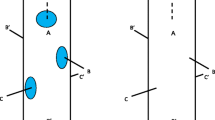Abstract
Borehole strain observation is playing an increasingly important role in the study on the crustal movements. It has been used by many countries such as China, USA, Japan, Peru, Australia, South Africa, Iceland and Italy, in research fields of plate tectonics, earthquake, volcanic eruption, dam safety, oil field subsidence, mining collapse and so on. Borehole strainmeter has been improved rapidly and tends to get more and more components included in one probe. Based on observations by this kind of instruments, studies on seismic strain step, slow earthquake, earthquake precursor and volcanic eruption forecasting have made remarkable achievements. In the coming years, borehole strain observation is going to become one major goedetic means, together with GPS and InSAR.
Similar content being viewed by others
References
Gladwin M T. 1984. High precision multi-component borehole deformation monitoring [J]. Rev Sci Instru, 55: 2011–2016.
Ishii H, Yamauchi T, Matsumoto S, et al. 2002. Development of multi-component borehole instrument for earthquake prediction study: Some observed examples of precursory and co-seismic phenomena relating to earthquake swarms and application of the instrument for rock mechanics [A]. In: Ogasawara H, Ando M; Yanagiani, et al. eds. Seismic Process Monitoring [C]. Rotterdam: Balkema, 365–377.
Ishii H. 2001. Development of new multi-component borehole instrument [R]. Report of Tono Research Institute of Earthquake Science, 6: 5–10 (in Japanese).
Linde A T, Gladwin M T, Johnston M J S, et al. 1996. A slow earthquake sequence near San Juan Bautista, California in December 1992 [J]. Nature, 383: 65–69.
McGarr A, Sacks I S, Linde A T, et al. 1982. Coseismic and other short-term strain changes recorded with Sacks-Everston strainmeters in a deep mine [J]. South Africa, Geophys J R Astr Soc, 70(3): 717–740.
QIU Ze-hua, ZHANG Bao-hong. 2002. Current situation of the seismological networks for borehole stress-strain precursor surveillance in China [J]. Recent Developments in World Seismology, 6: 5–9 (in Chinese).
Sacks I S, Evertson D W. 1971. Sensitive borehold strain-rate meter [J]. Carnegie Inst, Washington Yearb, 68: 448–453.
Sacks I S, Suyehiro S, Evertson D W, et al. 1971. Sacks-Evertson strainmeter, its installation in Japan and some preliminary results concerning strain steps [J]. Pap Met Geophys, 2: 195–207.
Sacks I S, Suyehiro S, Linde A T, et al. 1978. Slow earthquake and stress distribution [J]. Nature, 275: 5 681, 599–602.
Sakata S. 1981. On the concept of some newly-invented borehole three-component strainmeters [J]. Rep Nat Res Center Disaster Pre, 25: 95–126 (in Japanese with English abstract).
Stefansson R, Sacks I S, Linde A T. 1981. The Hekla eruption of 1980—the mechanism of a ridge volcano [R]. Annual Report of the Director. Department of Torrestrial Magnetism, Carnegie Inst, 511–514.
Author information
Authors and Affiliations
Additional information
Foundation item: National Natural Science Foundation of China (40374011) and Joint Seismological Foundation of China (1040037).
About this article
Cite this article
Qiu, Zh., Shi, Yl. Developments of borehole strain observation outside China. Acta Seismologica Sinica 17 (Suppl 1), 172–178 (2004). https://doi.org/10.1007/s11589-004-0081-6
Received:
Revised:
Accepted:
Issue Date:
DOI: https://doi.org/10.1007/s11589-004-0081-6




